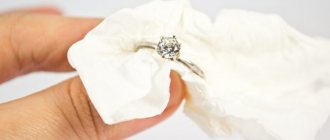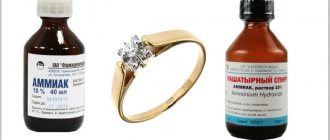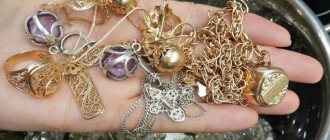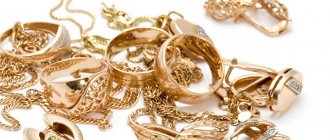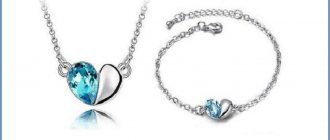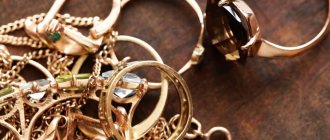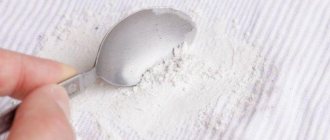Everyone who wears jewelry has experienced the fact that the product begins to fade over time. Therefore, many begin to wonder how to clean gold and silver in order to give it the appearance of just purchased jewelry? There are many answers to this question, and each method is good in its own way. Today we will talk about how to clean gold with ammonia and other means that cope with this task perfectly. They also include vinegar, salt, alcohol, soap, vodka, sugar, onions and even lipstick. Now in more detail about the most used and reliable methods.
The reason for the darkening of gold
Not everyone knows that gold in its pure form has no tendency to change in any way. This is only due to its combination with other, cheaper materials. Thus, jewelry production becomes cheaper, which makes it possible to save money. Gold can be alloyed with metals such as silver, copper, nickel, zinc or palladium. They are the ones that can undergo changes under the influence of oxygen and water.
The shine of jewelry also disappears due to the fact that gold is constantly on the human body, which, in turn, can secrete sweat or fat, and they rid the metal of its original state.
Precautionary measures
Ammonia and ammonia are chemicals that have a number of properties that can be harmful to human health. When using, you must observe the following precautions:
- Use rubber gloves when handling gold.
- Due to the pungent odor of the solution, the composition should be diluted in a well-ventilated room or outdoors.
- Before starting work, you must wear a mask, as ammonia is a toxic substance.
- Avoid contact with eyes and facial skin.
- Patients with vegetative-vascular dystonia are prohibited from working with the drug.
Cleaning gold with ammonia
Before starting cleaning, it is advised to understand the nature of the contamination itself in order to understand what measures to take to obtain the most effective result. Dirt can be in the form of dust that has adhered over time or caused by oxidation of the metal. In simple situations, use water and soap, make a solution from them and safely remove dirt from the jewelry.
Important! The nature and degree of contamination directly determines the cleaning method used for a more effective result, which will help avoid possible damage to jewelry.
But if the metal has oxidized, you can tell by the black and greenish spots on the gold. In this case, the most effective method
Gold cleaning will include 3 stages:
- Primary cleaning.
- Cleaning with chemicals.
- Mechanical cleaning.
Now it’s worth taking a closer look at what each stage will include separately.
What samples will withstand this treatment?
Ammonia, as a powerful solvent, removes substances from the surface being cleaned. Moreover, the reagent does not react with gold, silver, platinum and other metals that are used to create jewelry alloys.
If low-quality materials were used to create the alloy, or it has a low standard, for example, 375 or 500, the surface may be damaged during cleaning. It is not recommended to use ammonia to treat matte finishes.
The test will allow you to select the degree of concentration of the active element:
- 585 – up to 30%;
- 750 – up to 50%.
Do not chemically wash objects made of colored gold and gilded silver.
Primary cleaning
Before you clean gold with ammonia at home yourself, the first thing you can do is make a soap solution. It will help get rid of a small layer of dirt that occurs when metal comes into contact with the human body.
To prepare it, take water with a temperature of approximately 55 degrees and add any detergent of your choice to it.
For example, powder, dish gel or ordinary soap. The only thing is that it is not recommended to use overly aggressive cleaning products in particularly difficult situations. The first washing should be carried out in a gold-friendly mode.
When everything is ready, you need to dip the gold product into the resulting mixture and leave it inside for several hours. Then you need to take it out and clean it with a moderately hard brush. After the work done, the first positive results will be visible - the decoration will become cleaner even in the most inaccessible places, such as fastening stones or other recesses and protrusions. The gold is then washed with clean water and dried.
Advantages and disadvantages of this method
The main advantages of using ammonia include:
- Availability of the product. Ammonia is freely sold in pharmacies; the price for a 40 ml bottle starts from 8 rubles.
- Efficiency. Most contaminants can be removed.
- Safety. If you follow proven recipes, then using the product will not cause harm to your health.
- Return to original appearance.
Ammonia is not a universal means of cleaning gold; its use has disadvantages:
- Not suitable for processing semi-precious stones.
- Strong smell.
- Precautionary measures are required because... the substance is considered toxic.
- Not suitable for items with a matte finish.
- Small parts and hard-to-reach areas will require manual cleaning.
Chemical cleaning
Ammonia can be used as one of the best means for removing oxidation because it can effectively rid gold of any ingrained dirt without harming the product itself. People most often use several methods for cleaning gold with ammonia:
- This will be the first method: take a container with warm water, add half a teaspoon of ammonia to it along with 1 tsp. shampoo. Then the decorations are dipped into the resulting water and mixed thoroughly. Over time, dirt will appear in the water. Afterwards, the gold is pulled out and washed under ordinary water. The method showed itself quite well when cleaning gold with stones. To dry, just lay it on a napkin and wait.
- Another method involves a high-concentration ammonia solution, which can be purchased at any pharmacy. The method is used for particularly difficult cases. The pure liquid is poured into a container and contaminated objects are placed in it. The person regulates the time during which they are there, based on the degree of contamination of the metal. If the situation is difficult, the gold can be left in the solution overnight. In the morning, rinse and leave to dry.
- Another effective option is to use alcohol and washing powder. First you need a glass bowl, pour boiling water into it, add 1 large spoon of powder and a teaspoon of ammonia. Everything is mixed thoroughly, and then the decorations are placed inside for about an hour. If there is no powder at hand, any other similar product is used. Next, the gold is washed and dried. This will help avoid oxidation in the ligature, which can occur in undried jewelry during the first weeks after cleaning.
- There is a recipe that includes alcohol and peroxide. The method is quite aggressive, so it is not recommended to use it if the jewelry contains inserts or stones that are sensitive to chemical influences. To prepare the cleaning product, you will need a small saucepan with 200 ml. water in it. Also add 1.5 tablespoons of alcohol and 2 of the same tablespoons of peroxide. Then you need to drop about 0.5 teaspoon of liquid soap, mix and place the products there for a while. The result will be magnificent, even with the most difficult stains.
- There is another aggressive method that helps deal with products that have a large number of hard-to-reach places. Such jewelry includes chains with complex weaving or brooches. To successfully use this method, ammonia is mixed with ground chalk. The result should be a thick mixture with a specific odor. The gold is coated with this mixture so thoroughly that the product penetrates into all contaminated areas. Then you can cover the items or place them in a bag and wait until the mixture hardens or leave everything overnight, this will enhance the effect. Afterwards, you need to rinse the gold and dry it, wiping it with a napkin.
- The last option for getting rid of oxidation is the use of cleaning products and peroxide. How to clean gold with ammonia using such products? The answer is simple. You need a glass of warm water, 25-30 milligrams of 3 percent peroxide, a small spoon of ammonia and a small amount of soap, preferably liquid, by eye. All this is mixed, after which you can immerse the jewelry in the resulting solution and leave it there for 3-5 hours.
Note! Ammonia is able to cope with any pollution, except that which is characterized by the appearance of black spots. In this case, only a mechanical cleaning procedure will be effective.
What jewelry is not recommended to be processed?
Do not use ethanol ammonia or ammonia to clean white gold jewelry (an alloy containing platinum and nickel).
For the strength and shine of jewelry, the surface of the alloy is coated with a layer of rhodium, which protects the metal from exposure to the atmosphere and from interaction with the owner’s body. Some people are allergic to nickel - in this case, the rhodium layer protects the owner from allergic reactions.
Aggressive substances and careless cleaning can damage the protective layer and cause skin irritation for the owner.
Precious stones in rings and earrings can fade from exposure to ammonia and ammonia, so you should not treat items with zirconium, pearls, amber, garnet, malachite, turquoise, or coral with such aggressive substances.
Mechanical stripping
This stage becomes relevant if the second one did not show the proper result. This can happen because ammonia is not always able to cope with black oxidation, as it is provoked by sulfide irritants. In this case, mechanical cleaning will require an abrasive material.
It is not recommended to use dental and cleaning powders; they can damage jewelry, leaving scratches on its surface. If you use highly aggressive substances, they can affect the weight reduction of the product, since the gold alloys used may be excessively soft.
In a special store you can always buy the appropriate paste for processing gold jewelry. It contains vegetable oil and soapy water. Various powders are added as abrasives.
Before cleaning gold, you need to prepare a brush with medium-hard bristles. The paste is then applied to the product or to the brush itself. Do not press hard on the brush while cleaning; moderate force will be enough. When everything is ready, the decoration can be washed with alcohol, it will help to more thoroughly get rid of traces of the paste. Some prepare the product themselves and do not spend money on it, but to do everything correctly, you need to have some experience.
Ammonia is one of the best tools for cleaning gold because it does not risk damaging your jewelry.
Special cleaning pastes
In stores you can easily find special pastes designed specifically for cleaning yellow metal products. They usually consist of molar water, petroleum jelly, vegetable oil, lead carbonate, but more complex compositions can be used. To use, you need to apply a little special paste to a brush with soft bristles and gently wipe the surface of the product with this brush. Movements must be done in one direction. After this, you should rinse the product with vodka (removes fats remaining from the paste), but you can also get by with water. After this, carefully wipe the jewelry and let it dry.
How to clean jewelry with stones?
This is one of the most asked questions when it comes to cleaning jewelry. The entire procedure will include special gentle measures that will help not affect the integrity of materials susceptible to irritants. These include pearls, coral jewelry or bronze.
Experts recommend following a few simple rules:
✓ you should not overexpose such materials in cleaning liquids;
✓ it is necessary to prevent acid from coming into contact with the stones, this will destroy its structure;
✓ you cannot use abrasives in the form of paste or soda;
✓ You should not use powder or detergents for turquoise, this can cause it to become faded.
Important! For successful cleaning without harm to the stones, it is better to use alcohol and water with a regular napkin. For cleaning to always be effective, it must be carried out regularly as a preventive measure.
Rules for wearing, care and storage of gold items
You can preserve the original beauty of jewelry by following simple rules for storing and wearing jewelry.
It is better to place jewelry in boxes with fabric upholstery so that the items do not come into contact with each other. You can use fabric bags for this. Prolonged exposure to sunlight and water should be avoided.
Basic wearing rules:
- Jewelry should be removed at night, when swimming, playing sports, cleaning, washing dishes, and using cosmetics.
- It is important to clean regularly.
How to clean gold with dish soap and salt?
Any dish gel, for example Gala, is suitable for cleaning with detergent. The procedure is very simple and accessible to everyone. You need to take a glass of water and a large spoon of detergent, mix them, and put the items there for 2-3 hours. Then the gold needs to be taken out and further cleaned; a used toothbrush is good for this. But if the jewelry contains fragile stones, this method will not work.
The following method works well for staining gold chains. What is good about this method is its simplicity and low cost, but at the same time its effectiveness. To prepare the necessary solution, you only need water and three tablespoons of salt. All this is mixed, and then the gold can be lowered into the water. For greater efficiency, it is recommended to stir the water from time to time. Jewelry can be removed after 8-9 hours. And then rinse and dry.
Preparing the product for cleaning
To clean silver or gold with ammonia, you may need:
- Toothbrush;
- sponge, wool or flannel fabric (under no circumstances should you use abrasive substances or hard brushes to clean silver: they can scratch it and ruin the appearance of the product);
- a container for the solution (it should be borne in mind that it cannot subsequently be used for cooking);
- paper napkins;
- rubber gloves and tweezers.
Soap and water as a gold cleaner
Rather, soap and water are used as a preventive measure that will help avoid difficult to remove stains and will help ensure that jewelry always has the shine and appearance of a newly purchased item. To do this, just make soapy water and place rings, chains and earrings there for about a couple of hours. If they are not cleaned enough, you can additionally use a non-hard brush.
Ordinary laundry soap is especially suitable for obtaining a soap solution.
To make the task of preparing the mixture easier, grate it and fill it with hot water. You can also add a little white chalk here, half a standard piece. Keep the gold in the liquid for 2 hours. After drying and washing, you can use the flannel as a polish.
What will you need to prepare the solution?
- 200 ml. warm water.
- The third part of a small spoon of Vaseline.
- Chalk.
- Soap shavings.
To protect gold from severe contamination, it is enough to carry out such procedures once every 2-3 months.
Reviews of these methods
After looking at a large number of reviews about these methods on the global network, we can conclude that they are effective. However, it should be remembered that a specific method is suitable for each specific contamination. If it is heavily soiled, you should not try to clean the gold with a solution of water and sugar; it will not be able to cope. And, conversely, for light stains it is not necessary to use ultrasonic cleaning; ordinary soapy water will do.
You should not neglect contacting a jewelry workshop. There, craftsmen will be able to restore its former purity and shine in a matter of minutes and will not harm the expensive jewelry. Moreover, the cost for such a service will not make the owner regret it.
It should be remembered that proper care of gold jewelry will preserve the shine and beauty of the product. Regular care is required. It is expressed in simple daily washing of a product made of precious material. This will remove dust and sweat that appears after a day's wear. Plain water with soap or shampoo is suitable for cleaning.
Take a soft cloth, moisten it with this solution and wipe the product with gentle movements. After this, rinse it in running water and wipe dry with a cloth. This will only take five minutes and will not only preserve the beautiful appearance of the gold, but also protect it from all kinds of inflammatory processes. You should not neglect this, otherwise you may lose the opportunity to wear earrings for a long time, and this is only in the best case. Moreover, the answer to the question “how to clean gold?” already received.
Lipstick
This method is practically unknown and little used among the people, so everyone is very surprised when they hear about it for the first time. At first it is not entirely clear how this is possible, and people are skeptical about it. But there are people who have tested it on themselves and done it quite effectively.
Women often accumulate a large amount of used or outdated lipsticks, and these can be used to great advantage for jewelry.
Many people ask why lipstick and what is it about it that helps clean gold from dirt. This is because it contains titanium dioxide, which is what copes with dirt.
To clean, you need to take the lipstick and rub it on earrings, gold chain rings and other items, then wipe with a regular dry cloth and rinse under the tap. The result will appear immediately. This is one of the fastest and easiest ways to restore your jewelry to its original condition.
How to clean medical gold at home
Medical gold is an alloy of titanium, silver, brass, copper and zinc. Gold itself may not be included in this composition at all. Products made from such gold are highly durable and are not subject to mechanical stress. Thanks to a special method of polishing and spraying, the jewelry retains its original shine and does not darken or change color.
Wipe gold items dry if they have been exposed to moisture.
If the need arises, medical gold can be cleaned of contaminants in the following way:
- The glass must be filled halfway with water, add 2 drops of liquid soap or shampoo to it. Use a soft brush to clean.
- You can remove dust using a cotton swab previously soaked in beer. There is no need to rinse the product under water.
- The decoration can be wiped with table vinegar and then rinsed under waste water.
Remove rings and bracelets before cleaning, going to the bathhouse or sauna, and when removing nail polish.
